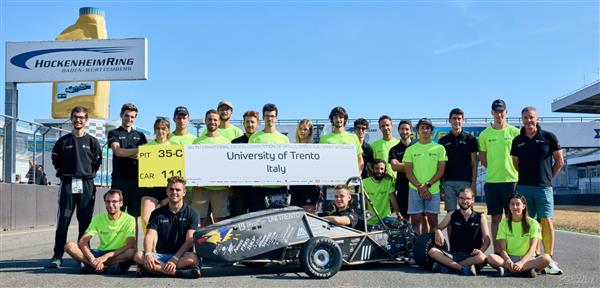E-Agle Trento Racing Team | Formula Student
The team
E-Agle Trento Racing Team is the university of Trento’s Formula Student team, composed of more than 80 students with different backgrounds and pursuing different studies, including computer, mechanical and electronics engineering, physics and economics.

Last season was a quite remarkable one, seeing our last car, Fenice, rolling out at Formula SAE Italy and Formula Student Germany. Here are some highlights about it:
We participated in Europe's most ambitious competition, Formula Student Germany
We were the only Italian team able to finish the endurance race at both Formula Student Germany and Formula Student Italy
At Formula Student Italy, we placed 3rd at the engineering design event and 11th overall out of 26 participants in the electric competition
At Formula Student Germany, we placed 11th out of 64 at the endurance race
Our electronics are designed and assembled completely in-house (except for the HV inverters, which we are planning to design in the following years)
Electronics
We are now working on next season’s car, Fenice EVO, which will keep the strength points of Fenice, while solving all the major and minor problems that we’ve encountered. For it we’ll develop many new boards, including the following:
- HV BMS
- LV BMS
- ECU
- Steering Wheel
- BSPD
- TSAL/Brakelight
HV BMS
The High Voltage Battery Management System consists of a distributed BMS made of 6 slave boards and a master one. These work together to manage the 600[V] tractive system accumulator.
LV BMS
The Low Voltage Battery Management System handles all systems that are not part of the tractive system. It includes cell monitoring and balancing, power distribution, fusing, cooling control and inverter enabling.
ECU
The Electronic Control Unit is the brain of the car. It acquires data from all sensors, hosts the state machine of the car and sends torque requests to the motors. It also interfaces with a Raspberry PI, which runs the torque vectoring and slip control algorithms.
Steering Wheel
The Steering Wheel PCB enables our drivers to seamlessly interface with the car. It has 3 rotary switches, 5 push buttons and 4 paddles. As the output interface it uses a 5” LCD display.
BSPD
The Brake System Plausibility Device is a fundamental safety component which checks if the brake is pressed and there is power delivered to the tractive system. In case this is true it opens the shutdown safety circuit and disables the high voltage system.
TSAL/Brakelight
As required by the rules, there must be a light that indicates the status of the tractive system and another one that indicates whether the brake pedal is pressed. These functions are performed by the same PCB design with different configurations.
- Comments(0)
- Likes(0)
















